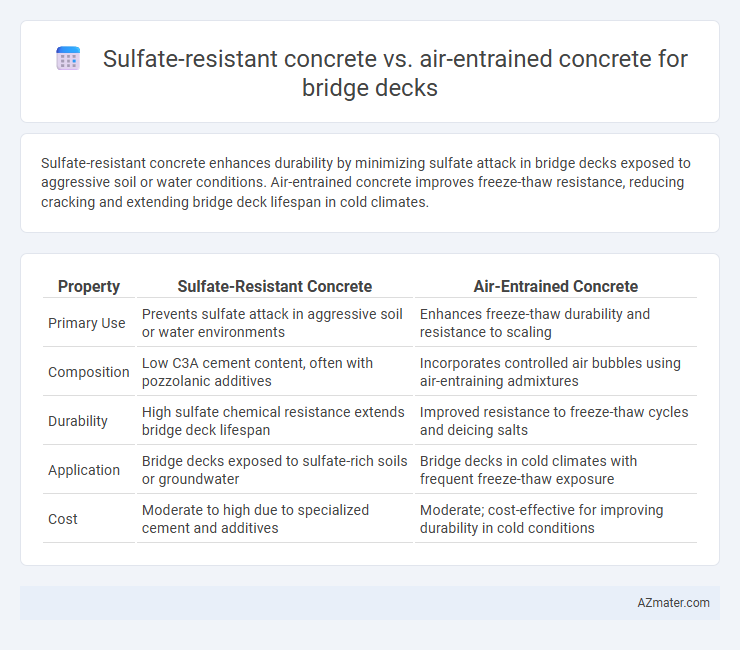Sulfate-resistant concrete enhances durability by minimizing sulfate attack in bridge decks exposed to aggressive soil or water conditions. Air-entrained concrete improves freeze-thaw resistance, reducing cracking and extending bridge deck lifespan in cold climates.
Table of Comparison
| Property | Sulfate-Resistant Concrete | Air-Entrained Concrete |
|---|---|---|
| Primary Use | Prevents sulfate attack in aggressive soil or water environments | Enhances freeze-thaw durability and resistance to scaling |
| Composition | Low C3A cement content, often with pozzolanic additives | Incorporates controlled air bubbles using air-entraining admixtures |
| Durability | High sulfate chemical resistance extends bridge deck lifespan | Improved resistance to freeze-thaw cycles and deicing salts |
| Application | Bridge decks exposed to sulfate-rich soils or groundwater | Bridge decks in cold climates with frequent freeze-thaw exposure |
| Cost | Moderate to high due to specialized cement and additives | Moderate; cost-effective for improving durability in cold conditions |
Introduction to Sulfate-Resistant and Air-Entrained Concrete
Sulfate-resistant concrete is formulated to withstand sulfate attacks from soil and groundwater, making it ideal for bridge decks exposed to aggressive sulfate-rich environments. Air-entrained concrete contains microscopic air bubbles that improve freeze-thaw durability and reduce cracking, crucial for bridge decks in cold climates. Both types enhance the longevity and structural integrity of bridge decks by addressing specific environmental challenges.
Importance of Concrete Selection for Bridge Decks
Concrete selection for bridge decks critically impacts durability and structural integrity, with sulfate-resistant concrete offering enhanced protection against chemical attacks in sulfate-rich environments, reducing costly maintenance. Air-entrained concrete improves freeze-thaw resistance by incorporating microscopic air bubbles, essential for regions with severe winter climates. Choosing between sulfate-resistant and air-entrained concrete depends on environmental exposure and load demands, ensuring long-term performance and safety of bridge decks.
Chemical Composition and Properties
Sulfate-resistant concrete contains low tricalcium aluminate (C3A) cement to minimize sulfate attack, enhancing durability in aggressive sulfate environments commonly found in bridge decks exposed to deicing salts and seawater. Air-entrained concrete incorporates microscopic air bubbles that improve freeze-thaw resistance and reduce internal pressure from water expansion, making it essential for bridge decks in cold climates. Both types optimize chemical composition and physical properties to address specific environmental stresses, ensuring longer service life and structural integrity.
Resistance to Environmental Factors
Sulfate-resistant concrete exhibits superior resistance to chemical attack from sulfate-rich environments, making it ideal for bridge decks exposed to aggressive soil or groundwater conditions. Air-entrained concrete enhances durability by improving freeze-thaw resistance through microscopic air bubbles that reduce internal pressure during temperature fluctuations. Selecting sulfate-resistant concrete ensures protection against sulfate-induced deterioration, while air-entrained concrete provides effective defense against cracking from cyclic freezing and thawing.
Performance Under Freeze-Thaw Cycles
Sulfate-resistant concrete exhibits enhanced durability against chemical attacks but often shows limited resistance to freeze-thaw cycles in bridge decks compared to air-entrained concrete, which incorporates engineered air voids to mitigate internal pressure from freezing water. Air-entrained concrete significantly reduces microcracking and scaling caused by cyclic freezing and thawing, resulting in prolonged service life for bridge decks exposed to harsh winter conditions. Performance evaluations indicate that air-entrained concrete is generally superior in maintaining structural integrity under severe freeze-thaw environments, making it the preferred choice for climates with frequent temperature fluctuations.
Durability in Sulfate-Rich Environments
Sulfate-resistant concrete is specifically designed with low C3A content cement to prevent chemical attacks from sulfate ions, significantly enhancing durability in sulfate-rich environments commonly found in bridge decks exposed to aggressive soils or groundwater. Air-entrained concrete improves freeze-thaw durability by creating microscopic air bubbles that relieve internal pressure but offers limited protection against sulfate-induced degradation. For bridge decks in sulfate-rich environments, sulfate-resistant concrete provides superior long-term resistance to sulfate attack, reducing the risk of expansion, cracking, and spalling that compromise structural integrity.
Workability and Placement Differences
Sulfate-resistant concrete typically exhibits lower workability due to its denser cementitious matrix designed to resist chemical attack, requiring careful admixture adjustments and prolonged mixing to ensure ease of placement on bridge decks. Air-entrained concrete, enhanced with microscopic air bubbles, offers superior workability and improved freeze-thaw durability, facilitating smoother placement and compacting in harsh weather conditions. The key difference lies in sulfate-resistant concrete's emphasis on chemical resilience affecting its rheology, while air-entrained concrete prioritizes frost protection and ease of handling during deck construction.
Cost Implications and Long-Term Maintenance
Sulfate-resistant concrete typically incurs higher initial costs due to specialized cement and additives but offers significant savings in long-term maintenance by preventing sulfate-induced deterioration in bridge decks. Air-entrained concrete, while generally more economical upfront and effective at resisting freeze-thaw cycles, may require more frequent repairs and surface treatments when exposed to aggressive sulfate environments. Selecting sulfate-resistant concrete enhances the durability and lifecycle performance of bridge decks in sulfate-rich conditions, reducing overall lifecycle expenses despite higher initial investments.
Case Studies: Bridge Deck Applications
Case studies on bridge deck applications demonstrate sulfate-resistant concrete's effectiveness in protecting structures exposed to aggressive sulfate-rich soils and groundwater, significantly reducing deterioration and extending service life. Air-entrained concrete in bridge decks enhances freeze-thaw durability by incorporating microscopic air bubbles, which prevent cracking in regions with repeated freeze-thaw cycles. Comparative analyses reveal sulfate-resistant concrete excels in chemical durability, while air-entrained concrete provides superior mechanical resilience against environmental stresses common in bridge deck environments.
Conclusion: Choosing the Optimal Concrete for Bridge Deck Durability
Sulfate-resistant concrete enhances bridge deck durability by preventing chemical attacks in sulfate-rich environments, reducing cracking and spalling risks. Air-entrained concrete improves freeze-thaw resistance, essential in cold climates to maintain structural integrity. Selecting the optimal concrete depends on environmental exposure; sulfate-resistant concrete suits aggressive sulfate conditions, while air-entrained concrete is ideal for regions with frequent freeze-thaw cycles.

Infographic: Sulfate-resistant concrete vs Air-entrained concrete for Bridge deck
 azmater.com
azmater.com